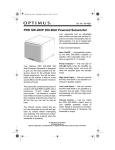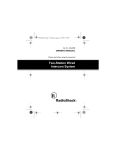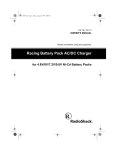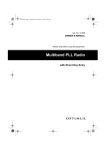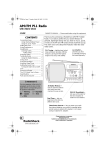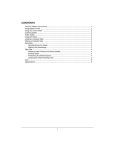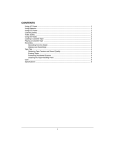Download Radio Shack Optimus Owner`s manual
Transcript
Cat. No. 12-798 OWNER’S MANUAL Please read before using this equipment. AM/FM Portable Radio with Dual Time, Single Alarm FEATURES Your Optimus AM/FM Portable Radio is designed for your active lifestyle. Its portable, lightweight design lets you listen to music, sports, or news on the AM and FM bands almost anywhere you go. The alarm clock and sleep timer features make this radio really useful. The radio’s features include: Two Band Selection — lets you listen to FM and AM stations. 20 Station Memory — lets you store ten stations in each band into memory for easy access. LCD Display — clearly shows the time and the currently selected station. Alarm Clock — turns on the radio automatically at a time you set. Sleep Timer — plays the radio for 10–90 minutes then automatically turns it off. Dual Timer — lets you keep track of the time in a different time zone. PLL Tuning — digital phase locked loop synthesizer provides drift-free frequency tuning with the highest degree of accuracy and stability. Built-in Speaker — provides quality sound that you can share with others. Earphone Jack — lets you connect earphones or headphones (not supplied) with a 1/8-inch plug to the radio. Lock Switch — prevents you from accidentally changing the tuned frequency. Display Light — lets you see the display in low light situations. DX/LOC (Sensitivity) Switch — lets you set the radio for the best reception of distant or local stations. Three Power Sources — let you power your radio from internal batteries, your vehicle’s cigarette-lighter socket (using an optional DC adapter), or AC power (using an optional AC adapter). © 1998 Tandy Corporation. All Rights Reserved. RadioShack is a registered trademark used by Tandy Corporation. 2 CONTENTS Preparation ............................................................................................ Supplying Power .............................................................................. Using Internal Battery Power ..................................................... Using AC Power ......................................................................... Using Vehicle Battery Power ...................................................... Setting the Clock .............................................................................. Using Earphones or Headphones .................................................... Listening Safely ......................................................................... Traffic Safety .............................................................................. Using the Stand ............................................................................... 4 4 4 5 5 6 7 7 7 8 Operation ............................................................................................... 9 Tuning the Radio .............................................................................. 9 Using the Station Memories ........................................................... 10 Using Lock ..................................................................................... 10 Lighting the Display ........................................................................ 11 Using the Sleep Timer ................................................................... 11 Using the Alarm ............................................................................. 11 Setting the Alarm Time ............................................................ 11 Turning the Alarm On and Off .................................................. 12 Maintenance ........................................................................................ 13 The FCC Wants You to Know ......................................................... 14 Specifications ..................................................................................... 15 3 PREPARATION SUPPLYING POWER Using Internal Battery Power When you use batteries, your radio requires four AA batteries for operation. It also uses two AAA batteries for clock and memory station backup. We recommend alkaline batteries, such as RadioShack Cat. No. 23-552 (for AA) and 23-555 (for the AAA size). Caution: Always use fresh batteries of the required size and recommended type. Follow these steps to install batteries. 1. Slide the battery compartment cover in the direction of the arrow and remove the cover. illustration 2. Put the two AAA batteries into the battery compartment on top of the attached ribbon, as indicated by the polarity symbols (+ and –) inside the compartment. illustration 3. Put the four AA batteries into the battery compartment as indicated by the polarity symbols (+ and –) marked outside and above the compartment. illustration 4. Replace the cover. If the radio operates erratically or does not receive strong FM stations, replace the AA batteries. Replace the AAA batteries about every six months. Caution: Dispose of old batteries promptly and properly. Do not burn or bury them. 4 Using AC Power To power the radio with AC power, you need an AC adapter such as RadioShack Cat. No. 273-1663 (not supplied). Cautions: • You must use an AC adapter that supplies at least 6 volts and delivers at least 300 milliamps. Its center tip must be set to negative and its plug must fit the radio’s DC 6V jack. The recommended adapter meets these specifications. Using an adapter that does not meet these specifications could damage the radio or the adapter. • Always plug the adapter into the radio before you plug it into the AC outlet. Always unplug the AC adapter from the AC outlet before you unplug it from the radio. 1. Set the adapter’s switch to 6 volts. voltage 2. Attach the adapter’s 5.5 mm outer diameter/2.1 mm inner diameter adaptaplug to the adapter, with TIP set to –. illustration 3. Insert the adaptaplug into the radio’s DC 6V jack. 4. Plug the adapter into a standard AC outlet. Using Vehicle Battery Power To power the radio from your vehicle’s cigarette-lighter socket, you need a DC adapter such as RadioShack Cat. No. 273-1802 (not supplied). Cautions: • You must use a DC adapter that supplies at least 6 volts and delivers at least 300 milliamps. Its center tip must be set to negative and its plug must fit the radio’s DC 6V jack. The recommended adapter meets these specifications. Using an adapter that does not meet these specifications could damage the radio or the adapter. 5 • Always plug the adapter into the radio before you plug it into the cigarette-lighter socket. Always unplug the DC adapter from the cigarettelighter socket before you unplug it from the radio. 1. Set the adapter’s voltage switch to 6V. illustration 2. Insert the adapter’s barrel plug into the radio’s DC 6V jack. 3. Insert the adapter’s cigarettelighter plug into the vehicle’s cigarette-lighter socket. Note: If the radio does not operate when you turn it on, remove the DC adapter from your vehicle’s cigarette-lighter socket and check the socket for debris. Also check the fuse in your adapter and your vehicle’s fuse block. SETTING THE CLOCK You can use Time 1 and Time 2 to keep track of the time in two different time zones. The alarm works only from the Time 1 setting. Follow these steps to set the clock. 1. Turn off the radio, then press TIME 1/2 to select Time 1 or Time 2. 1 or 2 appears. illustration 2. Press MEM/TIME. The display flashes. 3. Within 5 seconds, repeatedly press (or hold down) HOUR to set the hour. 4. Repeatedly press (or hold down) MIN to set the minute. Notes: • PM appears when the clock displays a PM hour. AM appears when the clock displays an AM hour. • When you change the minute setting for one time zone, it automatically changes for both. 6 USING EARPHONES OR HEADPHONES You can use the built-in speaker to listen to the radio. Or, you can use stereo earphones or headphones (not supplied) with 1/8-inch plug to listen privately. Insert the earphones’ plug into the radio’s jack. illustration Note: The built-in speaker disconnects when you connect earphones or headphones. Listening Safely To protect your hearing, following these guidelines when you use earphones or headphones. • Set the volume to the lowest setting before you begin listening. After you begin listening, adjust the volume to a comfortable level. • Do not listen at extremely high volume levels. Extended high volume listening can lead to permanent hearing loss. • Once you set the volume, do not increase it. Over time, your ears adapt to the volume level, so a volume level that does not cause discomfort might still damage your hearing. Traffic Safety Do not wear earphones/headphones while operating a motor vehicle or riding a bicycle. This can create a traffic hazard and could be illegal in some areas. Even though some earphones/headphones let you hear some outside sounds when listening at normal volume levels, they still can present a traffic hazard. 7 USING THE STAND You can use the radio’s stand to set the radio at an angle so you can easily see the display. Simply lift the stand away from the back of the radio and set the radio on a flat surface. illustration 8 OPERATION TUNING THE RADIO 1. Turn VOLUME to its lowest setting, then lift and fully extend the antenna. 2. Press POWER to turn on the radio. The last tuned frequency appears. illustration illustration 3. Slide BAND AM/FM to the desired band. illustration 4. If you selected the FM band, set SENS (Sensitivity) to DX or LOC. • DX (distant) – to receive weak (distant) signals illustration • LOC (local) – to receive strong (local) signals Note: SENS only works for FM reception. 5. Press TUNING + or – to tune up or down to the desired station. illustration To automatically tune the radio to the next strong signal, hold down TUNING + or – for about 2 seconds. 6. Rotate VOLUME to a comfortable level. 7. Slide TONE to HI or LO to suit your listening preference. illustration 8. To turn off the radio, press POWER again. 9 USING THE STATION MEMORIES You can store up to 20 stations (10 FM and 10 AM) into memory and quickly recall each. Follow these steps to store a station. 1. Turn on the radio and select a band (see “Tuning the Radio” on Page 9). 2. Press TUNING + or – to tune to the station you want to store. 3. Press MEM/TIME. MEMO flashes. illustration 4. Within 5 seconds, repeatedly press SELECT until the number for the desired memory location (1–10) appears. (Or, you can simply press a number button (1–5) to store a station in a memory location from 1 through 5.) The memory number appears on the display. illustration 5. Press MEM/TIME again to store the station. Note: If you do not store a station within 5 seconds, MEMO disappears. Repeat Steps 3–5. To tune to a stored station, press a number button, or repeatedly press SELECT until the number (1–10) for the desired memory location ap- pears. To replace a stored station, store a different station in its location. USING LOCK To avoid accidentally changing the station, set . This prevents the station from beLOCK to ing changed. 10 illustration LIGHTING THE DISPLAY To light the display for easy viewing in low light situations, hold down LIGHT. illustration USING THE SLEEP TIMER The sleep timer lets you go to sleep with the radio playing. The radio plays for up to 90 minutes, then turns off automatically. 1. Tune to the desired station. 2. Press POWER (if necessary) to turn off the radio. 3. Press SLEEP. SLEEP and 90 appear and the radio turns on. illustration To have the radio play for less than 90 minutes, repeatedly press SLEEP. With each press, the displayed number (representing the minutes the radio is set to play) decreases by 10. To turn off the radio before it automatically turns off, press POWER. USING THE ALARM You can set your radio to automatically turn on at a time you set. Note: The radio uses the Time 1 (not Time 2) setting for the alarm. Setting the Alarm Time 1. Press ALARM. The display flashes and ((((• appears. illustration 11 2. Within 5 seconds, repeatedly press (or hold down) HOUR to set the alarm hour. 3. Within 5 seconds, repeatedly press (or hold down) MIN to set the alarm minute. The alarm time is set and the ((((• appears, showing that the alarm is on. Turning the Alarm On and Off 1. Turn on the radio and tune to the station you want to hear at the set alarm time. 2. Adjust the volume to the desired level. 3. Turn off the radio. 4. To turn on the alarm, repeatedly press ALARM until ((((• appears on the screen. At the set alarm time, the radio turns on and plays until you turn it off. To turn off the alarm so it does not sound again the next day, repeatedly press ALARM until ((((• disappears. 12 MAINTENANCE Your Optimus AM/FM Portable Radio is an example of superior design and craftsmanship. The following suggestions will help you care for the radio so you can enjoy it for years. Keep the radio dry. If it gets wet, wipe it dry immediately. Liquids might contain minerals that can corrode the electronic circuits. Handle the radio gently and carefully. Dropping it can damage circuit boards and cases and can cause the radio to work improperly. Use and store the radio only in normal temperature environments. Temperature extremes can shorten the life of electronic devices, damage batteries, and distort or melt plastic parts. Keep the radio away from dust and dirt, which can cause premature wear of parts. Wipe the radio with a damp cloth occasionally to keep it looking new. Do not use harsh chemicals, cleaning solvents, or strong detergents to clean the radio. Modifying or tampering with the radio’s internal components can cause a malfunction and might invalidate the radio’s warranty and void your FCC authorization to operate it. If your radio is not performing as it should, take it to your local RadioShack store for assistance. 13 THE FCC WANTS YOU TO KNOW Your radio might cause TV or radio interference even when it is operating properly. To determine whether your radio is causing the interference, turn off your radio. If the interference goes away, your radio is causing it. Try to eliminate the interference by: • moving your radio away from the TV or other radio • connecting your radio to an outlet that is on a different electrical circuit from the receiver • contacting your local RadioShack store for help If you cannot eliminate the interference, the FCC requires that you stop using your radio. 14 SPECIFICATIONS Frequencies AM ............................................................................... 530–1710 kHz FM ............................................................................ 87.5–108.1 MHz Power Sources ........ 2 AAA Batteries (for backup) (Cat. No. 23-555) and 4 AA Batteries (Cat. No. 23-552) DC Adapter (Cat. No. 273-1802) AC Adapter (Cat. No. 273-1663) Dimensions (HWD) ............................................. 43/8 × 75/8 × 111/16 Inches 111 × 193 × 42 mm) Weight (Without Batteries) .......................................... 15 oz. (425.25 gm) Specifications are typical; individual units might vary. Specifications are subject to change and improvement without notice. 15 Limited Ninety-Day Warranty This product is warranted by RadioShack against manufacturing defects in material and workmanship under normal use for ninety (90) days from the date of purchase from RadioShack companyowned stores and authorized RadioShack franchisees and dealers. EXCEPT AS PROVIDED HEREIN, RadioShack MAKES NO EXPRESS WARRANTIES AND ANY IMPLIED WARRANTIES, INCLUDING THOSE OF MERCHANTABILITY AND FITNESS FOR A PARTICULAR PURPOSE, ARE LIMITED IN DURATION TO THE DURATION OF THE WRITTEN LIMITED WARRANTIES CONTAINED HEREIN. EXCEPT AS PROVIDED HEREIN, RadioShack SHALL HAVE NO LIABILITY OR RESPONSIBILITY TO CUSTOMER OR ANY OTHER PERSON OR ENTITY WITH RESPECT TO ANY LIABILITY, LOSS OR DAMAGE CAUSED DIRECTLY OR INDIRECTLY BY USE OR PERFORMANCE OF THE PRODUCT OR ARISING OUT OF ANY BREACH OF THIS WARRANTY, INCLUDING, BUT NOT LIMITED TO, ANY DAMAGES RESULTING FROM INCONVENIENCE, LOSS OF TIME, DATA, PROPERTY, REVENUE, OR PROFIT OR ANY INDIRECT, SPECIAL, INCIDENTAL, OR CONSEQUENTIAL DAMAGES, EVEN IF RadioShack HAS BEEN ADVISED OF THE POSSIBILITY OF SUCH DAMAGES. Some states do not allow the limitations on how long an implied warranty lasts or the exclusion of incidental or consequential damages, so the above limitations or exclusions may not apply to you. In the event of a product defect during the warranty period, take the product and the RadioShack sales receipt as proof of purchase date to any RadioShack store. RadioShack will, at its option, unless otherwise provided by law: (a) correct the defect by product repair without charge for parts and labor; (b) replace the product with one of the same or similar design; or (c) refund the purchase price. All replaced parts and products, and products on which a refund is made, become the property of RadioShack. New or reconditioned parts and products may be used in the performance of warranty service. Repaired or replaced parts and products are warranted for the remainder of the original warranty period. You will be charged for repair or replacement of the product made after the expiration of the warranty period. This warranty does not cover: (a) damage or failure caused by or attributable to acts of God, abuse, accident, misuse, improper or abnormal usage, failure to follow instructions, improper installation or maintenance, alteration, lightning or other incidence of excess voltage or current; (b) any repairs other than those provided by a RadioShack Authorized Service Facility; (c) consumables such as fuses or batteries; (d) cosmetic damage; (e) transportation, shipping or insurance costs; or (f) costs of product removal, installation, set-up service adjustment or reinstallation. This warranty gives you specific legal rights, and you may also have other rights which vary from state to state. RadioShack Customer Relations, Dept. W, 100 Throckmorton St., Suite 600, Fort Worth, TX 76102 We Service What We Sell 3/97 RadioShack A Division of Tandy Corporation Fort Worth, Texas 76102 5A8N Printed in Hong Kong
















